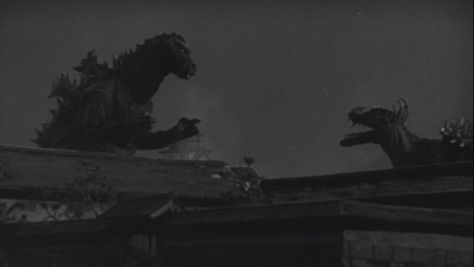

1964 was the turning point for the Godzilla films—after ten years and four movies, the series not only solidified into what it would be for the rest of the Showa era, but what it would be in all the years beyond that. After hitting on the kaiju battle premise in Godzilla Raids Again, King Kong vs. Godzilla, demonstrated that having multiple monster headliners duking it out brought in audiences like nothing else. As we have seen in the sixty years since then, it’s a pitch that finds its way back into public favour even after a period of downtime—watching two or more big monsters fighting hits a primal nerve.
These shifts in focus inevitably changed how the stories were written—for one, humanity was no longer living in a world where monsters were a freakish and tragic aberration, but one where they are woven into the fabric of existence. More importantly, though, was how all of this altered the depiction of Godzilla, which spoke of changing attitudes in Toho and possibly in the populace. Although the tone of the movies had significantly softened after the stark nuclear terror of Ishiro Honda’s original, one thing that stuck around even with the relative optimism of Raids Again or the lighthearted spectacle of KKvG was the idea of Godzilla as the ultimate threat, a walking disaster that humanity must contend with again and again as a constant reminder of what they had brought upon themselves. In 1954, Godzilla’s atomic origins made it feel like a new existential problem for life itself—but what happens when that becomes normalized? If Godzilla is eventually part of everyday life, how are we supposed to see him? Could he even become something more than a menace?
Circumstances at Toho led to the regular monster movie crew producing two movies in the Godzilla series in 1964 (with Dogora released between them), and you can see the drastic shift in the tone of this series happen in real time as you watch them. Godzilla gets one more round as the antagonist that brings humans (and more benevolent monsters) together—but within a few months, the tables turn completely, and it is Godzilla himself that humanity turns to for help from an even greater threat. There is something of a logical through line in this—Godzilla’s subsequent change into monster hero did not come from nothing—but it still rather dramatically realigned how these movies would be made from then on.
Continue reading Mothra vs. Godzilla & Ghidorah, the Three-Headed Monster (1964)






